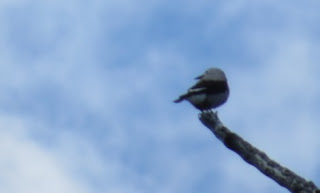 |
| ABA #571 |
My annual trip to Las Vegas, Nevada continues to pay off. Too bad the casino's are not as hot as the birding has been. While there on vacation, I manged to bird with birdingpal.org guide, John Taylor again. After visiting Henderson BP on Wends, Thursday morning we went north on SR 95 to Corn Creek NWP. Wow, what a place. But we needed to change the habitat and elevation to get different birds. So we moved north, then west off SR 156 up to Mt. Charleston. We drove from 2000 ft elevation up to 8100 ft elevation. Once at the Deer Creek Picnic area, off SR 158, we got out and walked up the trail. On the way out back to the parking lot . . . I keep glancing the top of the trees . . . then bang!!!
 |
| Clark's Nutcracker |
 |
| Nucifraga columbiana |
High in the mountains of the West, gray-and-black Clark’s Nutcrackers swoop among wizened pine trees, flashing white in the tail and wing. They use their dagger-like bills to rip into pine cones and pull out large seeds, which they stash in a pouch under their tongue and then carry away to bury for the winter. Each birds buries tens of thousands of seeds each summer and remembers the locations of most of them. Seeds they don’t retrieve play a crucial role in growing new pine forests.
Clark’s Nutcrackers are birds of the mountains. They are closely associated with pines that produce large seeds, such as whitebark pine and limber pine, but are also found in other montane evergreen forests from about 3,000 to more than 11,000 feet in the West.
 |
| Oh yeah . . Lifer!! |
Clark’s Nutcracker is in the crow and jay family—but the first time Captain William Clark saw one, in August of 1805, he thought it was a woodpecker. He and Meriwether Lewis collected a specimen in Idaho on their return journey a year later. Clark’s Nutcracker was one of three new bird species brought back from their expedition, all of which were described by the naturalist Alexander Wilson
Next up: Las Vegas birding . . . should I start a state list for NV yet??





No comments:
Post a Comment